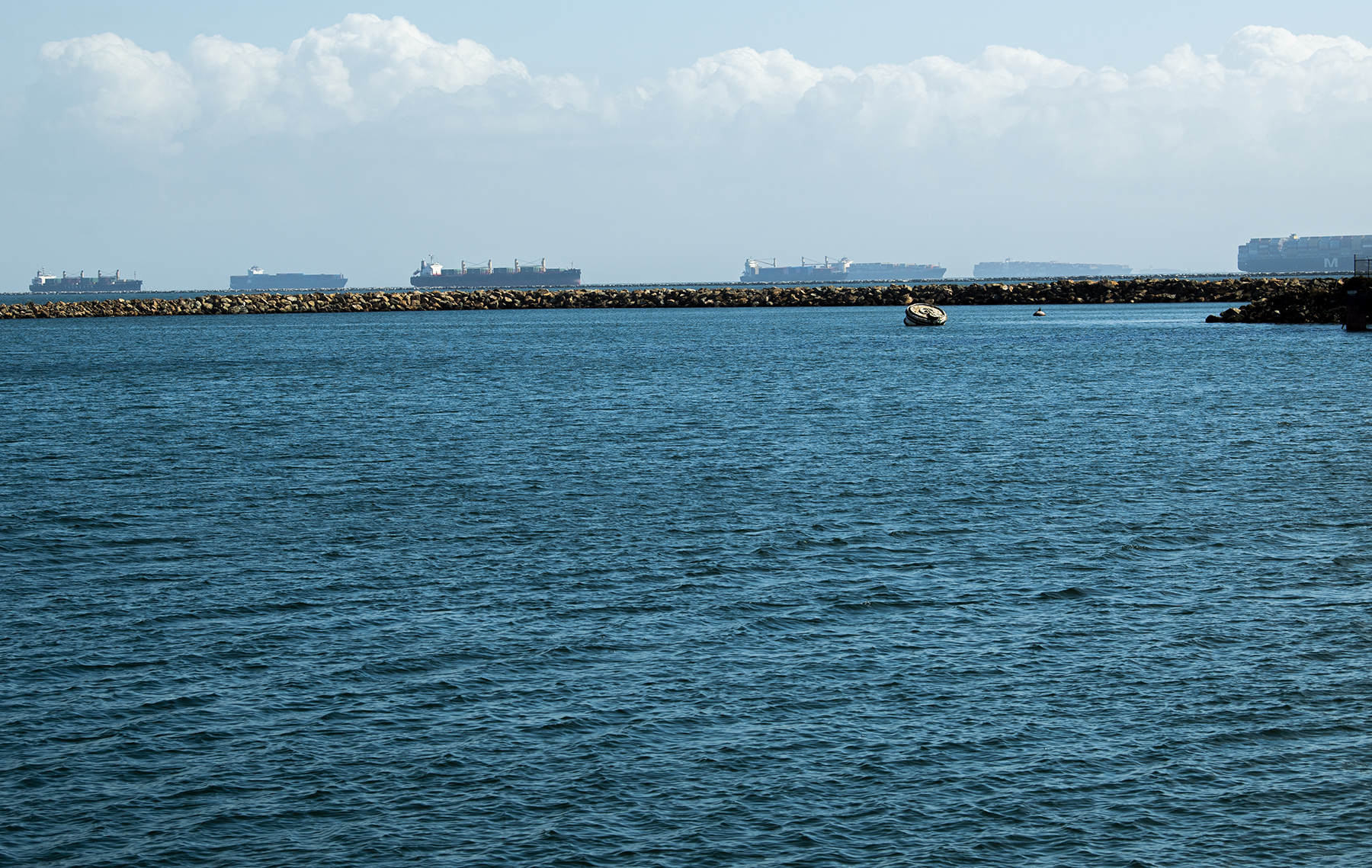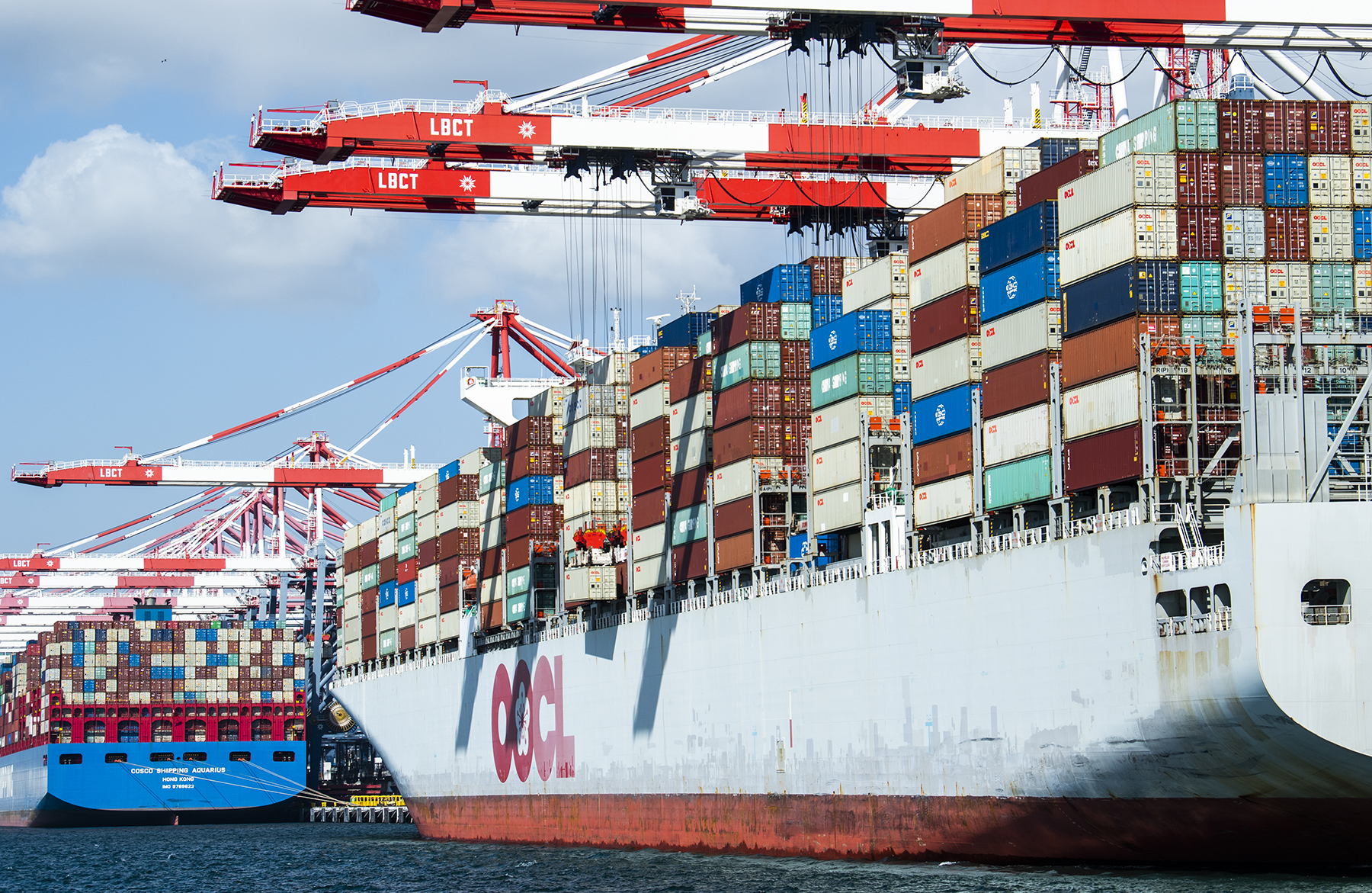
Congestion at the San Pedro Bay port complex shows no sign of easing, more than one year after a record-setting cargo surge began amid the COVID-19 pandemic, port officials say.
For months, a backlog of ships has been anchored off the Southern California coast waiting for space to open up at the ports of Long Beach and Los Angeles. The number of ships waiting off the coast reached a new record on Sept. 20 when 70 were at anchor or adrift, according to the Marine Exchange of Southern California.
Goods movement delays, though, are not unique to the San Pedro Bay ports.
“This is a global supply chain issue,” Port of LA Executive Director Gene Seroka said. “You’ve got cargo ships sitting outside of Savannah and Seattle in the United States, in addition to many other ports. So it’s not isolated here.”
Seroka, who previously worked in the industry overseas, said he remains in frequent contact with people in Europe, Asia and the Middle East. Most east-west trade gateways, he said, are “pretty full these days.”
While blame has largely been placed on the spike in online shopping during the public health crisis, the LA and Long Beach port directors say the current predicament is also the result of systemic issues: poor trade policy and “more than a decade of underinvestment” in West Coast ports have left their agencies vulnerable, Seroka said, to the challenges caused by the uptick in cargo they’re now seeing.
Fueling congestion
The woes at the San Pedro Bay ports began in 2018 when the Trump administration imposed billions of dollars in tariffs on a slew of Chinese imports in an attempt to correct the trade imbalance between the two countries. The tariffs, which remain in place, had the opposite effect.
“We were outspoken against these tariffs when they were contemplated and then implemented,” Seroka said, calling the Trump trade war a “failure of epic proportions.”
“The end result is that imports have increased, exports have declined and the trade gap with China has widened,” Seroka added, stating that exports have been down 30 of the last 34 months.
Both Seroka and Port of Long Beach Executive Director Mario Cordero are confident the Biden administration will re-examine the trade war to bring about an end to the tariffs. The port executives did stress, however, that any deals between the U.S. and China should aim to correct the trade imbalance and other issues.
“We will not succumb … to any trading nation that doesn’t share our ideals on worker empowerment, environmental stewardship and rules-based trade, but the phase one trade deal has been a failure,” Seroka said of Trump’s partial agreement with China signed in January 2020.
The top trading partners at the San Pedro Bay ports include China, Japan, Vietnam, Taiwan and South Korea, representing over 70% of imports. But high demand to quickly ship goods out of Asian markets has led to a shortage of containers on the West Coast, with a record number of empty containers being shipped back overseas rather than being filled with exports.
Empty containers outbound from Long Beach have consistently been in the mid-to-high 200,000s each month since September 2020, and even broke the 300,000-mark in May of this year for the first time in the port’s 110-year history.
The supply chain in the U.S. is facing other shortages that are compounding delays, including truck chassis. The majority of chassis are manufactured in China, but tariffs on the crucial piece of equipment have made them less available in the U.S.
Seroka said port authorities have asked the Biden administration to exempt chassis from tariffs immediately as a means to get more on the ground, while at the same time incentivizing manufacturing companies to build them closer to home.
But the tariffs are not the only cause for the chassis shortage, Seroka said. Dwell times at the ports are at their highest levels ever, he said, with containers sitting on chassis at the port for up to nine days, waiting for warehouse space to open up. The model for chassis provisioning was built on a three-and-a-half day turn time, he added. This also is causing further shortages in empty containers.
A lack of truck drivers also is fostering congestion, Seroka said, noting that there is a 20% annual attrition rate in the truck driving business nationwide.
“We have to find a way to attract, recruit and retain drivers,” he said.

Not unexpected and avoidable
Increased cargo movement through the San Pedro Bay port complex was not unexpected, Cordero said. In fact, estimates for 2021 are well behind projections made 14 years ago when Cordero was president of the Long Beach Board of Harbor Commissioners.
In 2007, the commission estimated some 35 million 20-foot equivalent units (TEUs)—the standard measuring unit for shipping containers—would pass through ports in 2020. Nearly a decade later, in 2016, the 2020 forecast was 19 million TEUs, Cordero said.
“So we knew many years ago what the volume was going to be here, so the volume should not be a surprise to us,” Cordero said. “The number of containers coming to this significant gateway are not going to be any less in the coming years.”
Last year, the Port of Long Beach moved just over 8.1 million TEUs, breaking its single-year record set in 2018 by about 20,000 TEUs. The Port of LA, meanwhile, moved 9.2 million TEUs, its fourth-highest volume in a single year.
This year, the ports are on track to surpass 20 million TEUs, according to Cordero, who said he would not be surprised to see 10 million TEUs pass through Long Beach. By 2040, the ports could be processing as many as 40 million TEUs, according to Seroka.
For years, the continuous increase in cargo volumes through the San Pedro Bay ports—the busiest port complex in the United States and in the top 10 globally—should have warranted far more investment by the federal government, Seroka said.
“What you see right now outside the ports of Long Beach and Los Angeles is more than a decade of underinvestment,” Seroka said, noting that the federal government has invested $11 billion in East Coast and Gulf Coast ports, compared to $1 billion on the West Coast over the last 10 years.
“I would argue that had we kept pace with the investment needs for infrastructure here—near-dock rail yards, digital infrastructure, roads, rail connectors—you wouldn’t see [dozens] of ships in the bay today,” he said.
The Biden administration’s landmark infrastructure bill, which has been tied up in Congress for months, includes $17 billion for port infrastructure, in part to reduce congestion. Seroka said the twin ports will campaign to receive their fair share of that money if and when the legislation is approved.

Short- and long-term solutions
At the federal and state levels, Cordero said there are a lot of good ongoing conversations about how best to deal with the challenges the San Pedro Bay complex and other ports face. The Biden administration has even gone as far as creating a Supply Chain Disruption Task Force, which includes the two port executive directors and is headed by John Porcari, who served as deputy secretary and COO of the Department of Transportation during the Obama administration.
In recent comments for U.S. Department of Transportation Secretary Pete Buttigieg, Seroka laid out 10 short- and long-term recommendations to ease port congestion in Southern California and across the country. In the short term, Seroka pushed for incentives for improved cargo flow, enhanced real-time info sharing, adjusted operations schedules and truck gate management, and better use of existing capacity, which is seeing 30% of truck appointments going unused.
In the long term—on top of increased infrastructure investment and improved trade policy—Seroka recommends various agencies and companies work as a multi-modal system rather than silos, improved supply chain digitization and a $140 million workforce training center to accelerate job growth and create a pipeline of skilled labor.
Locally, the ports of Long Beach and LA have taken it upon themselves to push policy to expedite cargo’s movement through the complex. The most recent effort came Sept. 17, when the ports sent a joint statement announcing expanded hours and a move toward 24/7 operations in what Cordero calls the “Amazon state of mind.”
Days after the initial announcement, the Port of Long Beach unveiled a pilot program at the Total Terminals International container terminal on Pier T that expanded truck gate hours with a third shift from 3-7 a.m. Monday through Thursday.
At Los Angeles, operations have been expanded with additional days and hours, Seroka said. Day and night productivity is up 50% compared to pre-surge figures, and every vessel that calls on the port loads and unloads 11,300 TEUs, on average. But despite their best efforts, delays persist.
“I have no expectation that this industry is going to move to [24/7] in the short term, but we’ve announced to the world and to the shippers that the Port of Long Beach is serious about extending gate hours,” Cordero said. “For this to work, for systemic change, it takes the entire supply chain and other stakeholders.”
“The onus is not just on the terminal operators, but everybody involved in the supply chain.”
